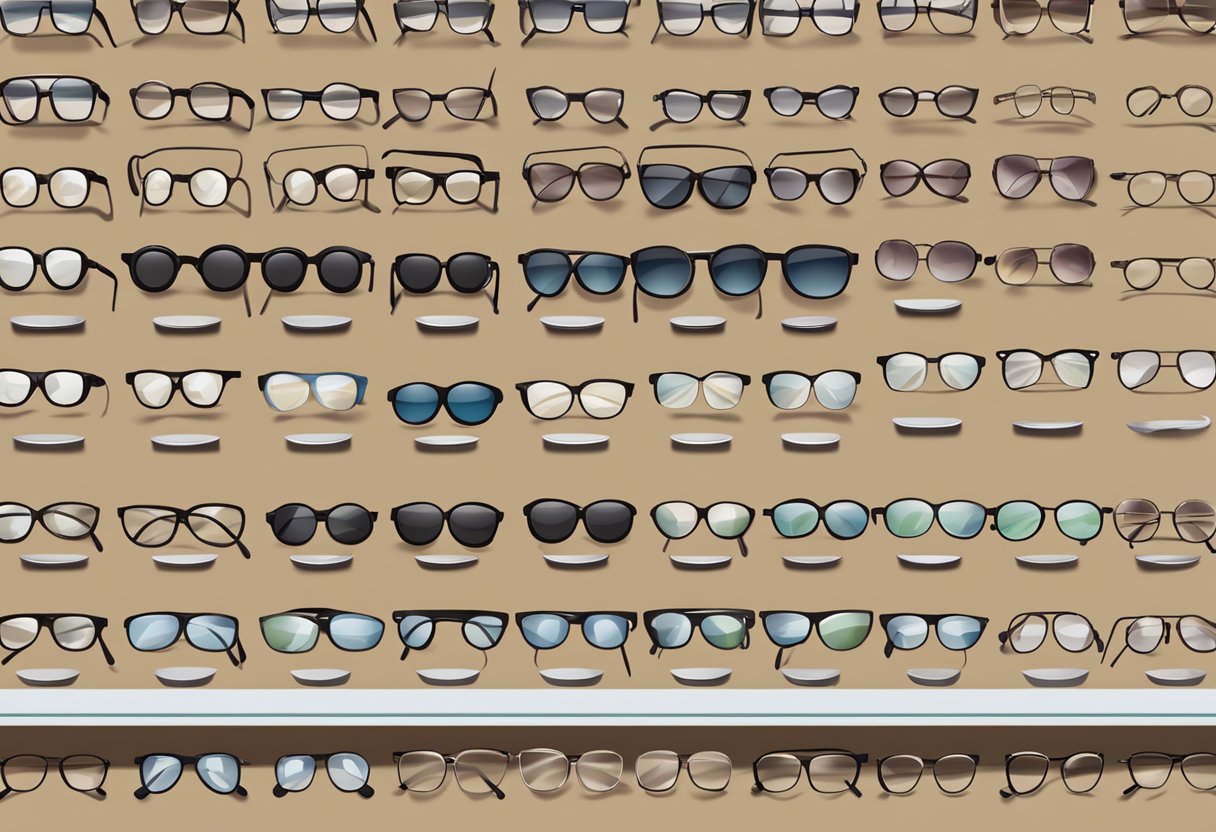Types Of Glasses
Glasses are an essential accessory for many people, whether they are used for vision correction or as a fashion statement. With so many types of glasses available on the market, it can be overwhelming to choose the right pair. This article will provide an overview of the different types of glasses, lens types and materials, frame styles and materials, lens enhancements and coatings, and tips for choosing the right glasses for your needs.
One of the first things to consider when choosing glasses is the type of glasses you need. There are several types of glasses, including prescription glasses, reading glasses, computer glasses, and sunglasses. Prescription glasses are designed to correct vision problems, while reading glasses are used to enhance near vision. Computer glasses are designed to reduce eye strain caused by prolonged computer use, while sunglasses protect the eyes from harmful UV rays.
When it comes to choosing the right glasses, there are several factors to consider. These include the shape of your face, your personal style, and your budget. It’s important to choose glasses that not only look good but also provide the functionality you need. With the right pair of glasses, you can improve your vision and enhance your overall appearance.
Key Takeaways
- There are several types of glasses available, including prescription glasses, reading glasses, computer glasses, and sunglasses.
- When choosing glasses, it’s important to consider factors such as the shape of your face, your personal style, and your budget.
- The right pair of glasses can improve your vision and enhance your overall appearance.
Types of Glasses

When it comes to glasses, there are several types available on the market. Each type of glasses serves a different purpose and is designed to meet specific needs. The following subsections will cover the most common types of glasses available.
Prescription Glasses
Prescription glasses are custom-made to correct vision problems such as nearsightedness, farsightedness, and astigmatism. They are designed to provide clear vision and are available in a wide range of styles and materials. Prescription glasses can be made with different types of lenses, including single-vision, bifocal, and progressive lenses. They can also be made with different coatings, such as anti-reflective, scratch-resistant, and UV-protective coatings.
Sunglasses
Sunglasses are designed to protect the eyes from harmful UV rays and glare from the sun. They come in different styles and colors and can be made with different types of lenses, such as polarized lenses, which reduce glare, and photochromic lenses, which darken in bright light. Sunglasses are also available with different coatings, such as anti-reflective and scratch-resistant coatings.
Reading Glasses
Reading glasses are designed to help people with presbyopia, a condition that makes it difficult to see close objects clearly. They are available over-the-counter and come in different strengths, ranging from +1.00 to +3.50 diopters. Reading glasses are available in different styles and materials, including metal and plastic frames.
Computer Glasses
Computer glasses are designed to reduce eye strain and fatigue caused by staring at a computer screen for long periods. They are available with different types of lenses, such as single-vision, bifocal, and progressive lenses. Computer glasses can also be made with different coatings, such as anti-reflective and blue-light-blocking coatings.
In conclusion, there are several types of glasses available on the market, each designed to meet specific needs. Whether you need prescription glasses to correct your vision, sunglasses to protect your eyes from the sun, reading glasses to help you read, or computer glasses to reduce eye strain, there is a type of glasses that can meet your needs.
Lens Types and Materials
There are several types of lenses available for eyeglasses, each with its own unique characteristics and benefits. The most common types of lenses include single-vision, bifocal and trifocal, and progressive lenses. Additionally, there are various lens materials to choose from, including glass, plastic, polycarbonate, and trivex lenses.
Single-Vision Lenses
Single-vision lenses are the most basic type of lenses and are used to correct a single vision problem, either nearsightedness or farsightedness. These lenses have a uniform curvature and provide clear vision at a single distance. They are an excellent choice for people who need glasses for reading or driving.
Bifocal and Trifocal Lenses
Bifocal and trifocal lenses are designed to correct multiple vision problems. Bifocals have two distinct areas of correction, one for distance vision and one for near vision. Trifocals have three areas of correction, one for distance, one for intermediate, and one for near vision. These lenses are an excellent choice for people who have difficulty seeing at different distances.
Progressive Lenses
Progressive lenses are similar to bifocal and trifocal lenses but provide a more gradual transition between the different areas of correction. They offer a more natural vision experience and are an excellent choice for people who want a more versatile lens.
Lens Materials
The most common lens materials are glass, plastic, polycarbonate, and trivex lenses. Glass lenses were once the most popular choice but have since been replaced by plastic lenses, which are lighter and more impact-resistant. Polycarbonate lenses are even more impact-resistant and are an excellent choice for people who play sports or work in hazardous environments. Trivex lenses are similar to polycarbonate lenses but are thinner and provide better optical clarity.
In conclusion, when choosing eyeglasses, it is essential to consider the type of lens and material that best suits your needs. Whether you need glasses for reading, driving, or working, there is a lens type and material that will provide clear, comfortable vision.
Frame Styles and Materials
Full-Rim Frames
Full-rim frames are the most common frame style and are composed of a complete rim that encircles the lenses. These frames are available in a wide variety of materials, including metal, acetate, titanium, monel, and stainless steel. Full-rim frames offer the most stability and durability, making them a great choice for people with stronger prescriptions or those who are more active.
Semi-Rimless Frames
Semi-rimless frames, also known as half-rim frames, have a rim that only partially encircles the lenses. The bottom half of the lenses are held in place by the frame, while the top half is left exposed. This style of frame is popular for its lightweight and minimalist design. Semi-rimless frames are typically made from metal or acetate.
Rimless Frames
Rimless frames have no frame surrounding the lenses and are held in place by a series of screws and nose pads. This style of frame offers a sleek and minimalist look and is a great option for people who want their glasses to be as unobtrusive as possible. Rimless frames are typically made from metal or titanium.
Frame Materials
When choosing glasses frames, it’s important to consider the material they are made from. Different materials offer different benefits, so it’s important to choose the one that best suits your needs.
- Metal frames are durable and corrosion-resistant, making them a great choice for people who are hard on their glasses. They are also lightweight and offer a sleek, modern look.
- Acetate frames are made from a type of plastic and are known for their durability and flexibility. They are available in a wide variety of colors and patterns, making them a popular choice for people who want to make a statement with their glasses.
- Titanium frames are lightweight, durable, and corrosion-resistant. They are a great option for people with sensitive skin or allergies, as they are hypoallergenic.
- Monel frames are made from a blend of metals and are known for their strength and durability. They are a great choice for people who want a frame that will last for years.
- Stainless steel frames are lightweight and corrosion-resistant. They offer a sleek, modern look and are a great choice for people who want a frame that is both durable and stylish.
- Flexon frames are made from a unique titanium alloy that is flexible and durable. They are a great choice for people who are hard on their glasses and want a frame that can withstand a lot of wear and tear.
Overall, when choosing glasses frames, it’s important to consider your personal style, the shape of your face, and your lifestyle. With so many frame styles and materials to choose from, there’s sure to be a pair of glasses out there that are perfect for you.
Lens Enhancements and Coatings
When it comes to eyeglass lenses, there are many different types of enhancements and coatings available to improve their performance and durability. Here are some of the most common types of lens coatings and enhancements:
Anti-Reflective Coatings
Anti-reflective coatings, also known as AR coatings, are applied to eyeglass lenses to reduce glare and improve clarity. They work by allowing more light to pass through the lens, which reduces the amount of light that is reflected back to the eye. This can be especially helpful when driving at night or working on a computer for long periods of time.
Scratch-Resistant Coatings
Scratch-resistant coatings are applied to eyeglass lenses to make them more durable and resistant to scratches. They work by creating a hard, protective layer on the surface of the lens that helps to prevent scratches from forming. While no coating can completely prevent scratches, scratch-resistant coatings can help to extend the life of your lenses and keep them looking new for longer.
UV Protective Coatings
UV protective coatings are applied to eyeglass lenses to protect the eyes from harmful UV rays. These coatings work by blocking out both UVA and UVB rays, which can cause damage to the eyes over time. While most eyeglass lenses already provide some level of UV protection, adding a UV protective coating can provide additional protection and peace of mind.
Photochromic Lenses
Photochromic lenses, also known as transition lenses, are lenses that darken in response to sunlight and then lighten when you move indoors or out of direct sunlight. These lenses are a great option for people who spend a lot of time outdoors, as they can help to reduce glare and eye strain. They are also a good option for people who don’t want to switch between prescription glasses and sunglasses throughout the day.
Overall, there are many different types of lens enhancements and coatings available to improve the performance and durability of eyeglass lenses. Whether you’re looking for anti-reflective coatings, scratch-resistant coatings, UV protective coatings, or photochromic lenses, there is a coating or enhancement that can help to meet your needs and improve your vision.
Choosing the Right Glasses
When it comes to choosing the right glasses, there are several factors to consider. Glasses not only serve as a vision correction tool but also as a fashion accessory. Therefore, it is important to choose glasses that not only fit your vision needs but also complement your face shape, fashion style, and lifestyle. Here are some factors to consider when choosing the right glasses:
By Face Shape
Different face shapes require different types of glasses. A person with a round face should opt for glasses that have angular frames to add definition to their face. Similarly, a person with a square face should choose glasses with rounded frames to soften their face’s angles. Those with an oval face shape are lucky as they can pull off most frame styles.
By Vision Needs
The type of glasses you choose depends on your vision needs. For instance, if you have presbyopia, you may require bifocal or progressive lenses. If you are nearsighted, you may need glasses with concave lenses, and if you are farsighted, you may require glasses with convex lenses. It is important to consult with an optometrist to determine the right type of glasses for your vision needs.
Fashion and Lifestyle
Glasses can also serve as a fashion accessory and should complement your style and lifestyle. If you are an athlete, you may require glasses that offer eye protection and are durable. On the other hand, if you work in an office, you may want to opt for glasses that are more stylish and professional-looking. It is important to choose glasses that not only fit your vision needs but also your lifestyle.
In conclusion, choosing the right glasses involves considering several factors, including face shape, vision needs, fashion style, and lifestyle. It is important to consult with an optometrist to determine the right type of glasses for your vision needs and choose glasses that complement your style and lifestyle.






